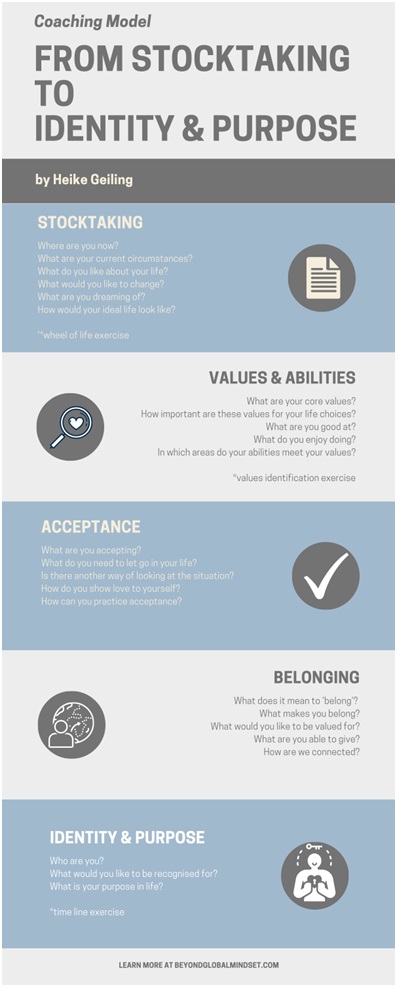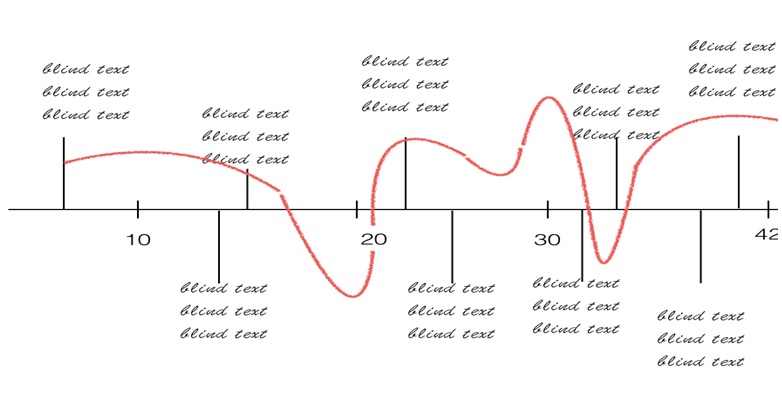A Coaching Model Created by Heike Geiling
(Intercultural Coach, SWITZERLAND)

In my coaching niche, I am offering my support to expats and expat partners who are dealing with cultural differences and who are trying to lead a purposeful life while living abroad.
Many of these expats are confronted with situations where they question their purpose in life and ask themselves who they truly are. These situations can be triggered by
What all clients have in common is that they are feeling a little lost, unique, alone, and doubtful. They don’t know what is wrong, they think that no-one can understand their particular situation, they feel like they have no-one to talk to, they would like to do something, but they are doubting that they are doing the right thing.
With my coaching model, they can be guided from a stocktaking process to identifying their values and abilities, accepting their situation as it is, creating a sense of belonging, and finally seeing their true identity and finding purpose in life.
Stocktaking
This fist step is an analysis of the current situation where the clients look at all aspects of their current life, where they reflect on their wishes and dreams and also on the boundaries they currently feel. The wheel of life exercise can help them to visualize which parts of their lives they are currently happy with and what they are currently missing.
This exercise starts a thinking process and already points into the direction the client would like to move to.
Values & Abilities
In the next step, we look at their values and at what they are good at and enjoy doing. Many people are not very aware of their core values which makes intercultural work or living in a different culture even more difficult. If you do not know your values, you are unable to identify what offended, disappointed, saddened you in the behavior of others. If you do not know your values, making life decisions becomes more difficult because you cannot set the right parameters to evaluate your decision. A values identification exercise helps to recognize core values and to differentiate other important values from less or non-important ones.
The fun part is to look at what the clients enjoy doing and what they are good at. The final objective of this second step is to match their talent with their values. For clients who like visualization, the creation of a vision board is a very helpful tool to use.
Acceptance
A common argument to explain the current situation is that the circumstances are just not right at the moment. The role is too demanding, the team is too diverse, the supervisor has no clue, the objective cannot be obtained in this country, circumstances don’t allow for the next step, everything was better in the previous place, … For some, this is the hardest part: to accept the status quo and thus free their minds for unlimited thinking. To accept and treat themselves with love and care to be ready for something new. By asking if there is another way of looking at the situation, the coach can help the client to change perspective and go from thinking in limitations to thinking of opportunities. If acceptance is hard for the client, the coach can also support the client by encouraging him/her to practice acceptance regularly.
Belonging
Once acceptance is working, we can start discussing belonging as belonging is another important criterion for a purposeful life that is often missing in expats’ lives. For a large number of expats, the only sense of belonging they can identify is the sense of belonging to their family. Many also feel they belong to the company or the teams they are working with.
A deep sense of love and belonging is an irreducible need of all people. We are biologically, cognitively, physically, and spiritually wired to love, to be loved, and to belong. When those needs are not met, we don’t function as we were meant to. We break. We fall apart. We numb. We ache. We hurt others. We get sick. (Brené Brown)
If the client can give an overview of all the groups s/he belongs to, the coach can support him/her in identifying what the benefits are from being in this group and what the client is currently contributing to the group and could contribute in the future. Everybody is a contributor in one way or another. Following Paul Watzlawik’s
You can not communicate”: Even if you do not actively contribute to a group positively or constructively, you do communicate something back to them (you don’t care, they are unimportant, you don’t like them, you are too busy with other things, you are unable to socialize with them, you are too shy, you are too full of yourself, …)
By understanding their role within a group and the potential that lies in being part of a group, they can seize the opportunities to easily connect with others and to create a sense of belonging at various levels.
Identity &Purpose
In this last step, everything comes together. Here we look at what has changed since the stocktaking, what are the core values, and the talents. How does the client see his/her current situation now? What did they let go of? How do they connect to others? How are they enriching their lives and the lives of others? Who are they? What would they like to be recognized for? What would they like to accomplish? To gain more clarity a timeline exercise can help to identify who they are without all the labels they have acquired throughout their life.
Who am I? The timeline exercise.

Draw a timeline for your life divided into 4 sections and add all significant events to it, refrain from mentioning career-related information. Then use a colored pen to add an emotional graph identifying the highs and lows in your past. Tell your life’s story without referring to any job title or role you held.
Who am I? Tell your story.
Look at your timeline again. How did you tell your story? How we tell our stories can greatly impact how we feel about ourselves. When did you feel proud of yourself? When did you feel authentic? When did you talk about yourself as a victim of circumstances? When did you feel most fulfilled?
My mission is to support people in creating a better life abroad and in improving their abilities to work better with others across cultural differences. I aspire to create a sense of belonging for everyone I encounter, show my true self, and stay committed to my ideas and plans. I hope that this model will support and inspire many people to find what they truly want in life.
To live with courage, purpose, and connection
to be the person whom we long to be –
we must again be vulnerable.
We must … show up, and let ourselves be seen.
Brené Brown